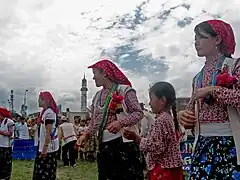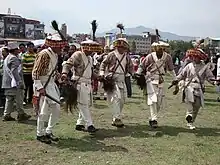Sakela
Sakela (Nepali: साकेला) is one of the main festival of Kirat Rai people, an ethnic group indigenous to Eastern Nepal and Sikkim, Kalimpong, and Darjeeling regions of India. Sakela is celebrated twice a year and is distinguished by two names Ubhauli and Udhauli. Sakela Ubhauli is celebrated during Baisakh Purnima (full moon day in the month of Baisakh) and Sakela Udhauli is celebrated during the full moon day in the month of Mangsir.[1][2][3]
| Sakela | |
|---|---|
 | |
| Also called | • Sakewa • Sakhewa • Sakenwa • Wass • Bhume • Folsyandar • Ubhauli • Udhauli • Tòsī • Tòsh • Eksamang • Segro • Fagulak |
| Observed by | Kirat Rais around the world |
| Type | Rai, Kirati Culture |
| Observances | Sakela sili, cultural group dance, religious services, family meetings, relative meetings |
| Begins | Sakela Udhauli (full moon day of Mangsir ) and Sakela Ubhauli (full moon day of Baishak) |
| Ends | After fifteen days |
| 2023 date | |
Significance
Kirats believe in shamanism and are worshippers of nature. The Sakela celebration is a prayer to mother nature for healthy crops and protection from natural calamities.[3] The festival is Started on Baisakh Purnima, Sakela Ubhauli is celebrated for 15 days in Baisakh (April/May) marking the beginning of the farming year. Similarly, the celebration of Sakela Udhauli during Mangsir (November/December), which is the harvest season, is the giving of thanks to mother nature for providing a good harvest.
Sakela dance
The main characteristic of this festival is a ritual dance call Sakela dance performed by large groups of Kirats, wearing their traditional attire. People from all ages dance together in a large circle. There are male and female leaders in each circle known as Silimangpa and Silimangma respectively. They choreograph the dance moves known as sili while others follow them. The sili reflects the different aspects of human life and their relationship with nature.[4]
Variations

Among the various Rai languages Sakela also called "Sakewa/Sakenwa" in Bantawa, Dungmali and Mewahang "Tosh in" Kulung and Nachhiring, "Toshi" in Thulung, "Segro" in Bahing, "Iksamang/Balipuja" in Lohorung and Yamphu, "Fagulak" in Puma all Rai people worship "land deity" (Bhumi dev) Mother Earth (deity) in this festival and perform various types of dance related to nature and Human civilization: farming, hunting, weaving, acting of birds, animals and insects etc the dance is called "Silli" in Rai languages like "Toshi silli", "Tosh silli", "Sakela silli", Sakenwa silli etc. Silli means dance.
Gallery
.jpg.webp) Offerings made to Paruhang and Sumnima, the ancestral deity
Offerings made to Paruhang and Sumnima, the ancestral deity Kirati Rai women in Sakela Ubhauli festival
Kirati Rai women in Sakela Ubhauli festival.jpg.webp) Women in traditional Rai wear (2019)
Women in traditional Rai wear (2019).jpg.webp) A Rai man playing traditional drum (Dhol)
A Rai man playing traditional drum (Dhol)
See also
References
- Gaenszle, Martin (1997). "Changing concepts of ethnic identity among the Mewahang Rai". Nationalism and Ethnicity in a Hindu Kingdom. The Politics of Culture in Contemporary Nepal: 351–373.
- Schlemmer, Grégoire (2004). "New past for the sake of a better future : re-inventing the history of the Kirant in East Nepal". European Bulletin of Himalayan Research. 25: 119–144.
- "Dancing to Ubhauli tunes". The Kathmandu Post. May 17, 2011. Retrieved 8 May 2012.
- Rai, Dik Bahadur (2012). The impacts of Modernization on the traditional Sakawa Sili festival in the Rai Kirat community of Nepal: a case study of the Rai community (Thesis). University of Tromsø.